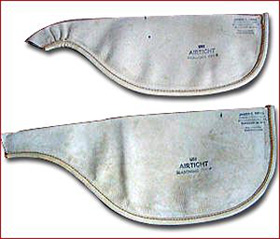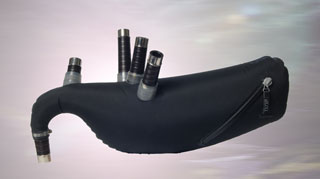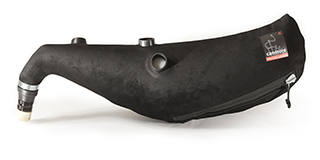

Choosing the Right Pipe Bag
by Ian Lyons
These days bagpipe bags comes in various types and sizes, so choosing the right pipe bag can sometimes be difficult. Here are a few tips to help you decide what is right for you.
There are several factors to take into consideration when buying and fitting a new pipe bag to your bagpipes.
Types of pipe bags
The two main categories of pipe bags are Hide and Synthetic. Hide pipe bags are made of animal skins such as sheepskin, goatskin and cow hide. Synthetic pipe bags are made from manmade breathable materials that are specially designed for bagpipe bags. Pictured below are 2 hide pipe bags (left) and a synthetic pipe bag (right)


There is now also a sub-category of synthetic pipe bags available which are referred to as Hybrid (below). This is essentially a synthetic pipe bag which is made from a faux (fake) leather. These bags give a similar feel to that of a hide pipe bag and are becoming very popular among pipers.

All the different types and brands of pipe bags comes in different shapes and sizes. What suits some pipers, may not suit others. Pipe bag makers try to cut and shape their pipe bags to conform to most peoples size and shape. It can be an expensive exercise to try and find exactly the right fit and shape for you, so it's important, if you can, to try out some other pipers bags to see what feels best.
Pipe Bag Sizes
Most pipe bag makers simply use Small, Medium & Large sizing as their main guide for bag sizes. There is a fair degree of uniformity amongst pipe bag makers. So, it's really a common-sense approach with Medium being the most commen size. So, if you are of medium build and height, then medium is for you. If you're a child or smaller than average, then a small pipe bag is for you etc....
Pipe bag makers also offer "Extended" pipe bags. Don't be confused by this! These pipe bags are extended at the back of the bag and are not bigger in the girth. So, the size is essentially the same. The extended bag purports to offer more volume of air within the bag for enhanced stabilty.
Other pipe bag makers offer a special cut of pipe bag which may be named after a famous piper or given a special name. These might have the drone collars placed slightly further forward or the blowpipe slightly back. Again, this may suit them, but not neccessarily suit you.
Trial and error is the best approach!
Fitting, access and adding moisture control
Hide pipe bags and synthetic pipe bags are usually fitted in different ways but some synthetic and hybrid versions can be fitted in both ways.
Traditionally, hide pipe bags are tied-on. This is a skill usually passed on by experienced pipers, where the holes have to be marked on a blank bag and carefully cut out in the most suitable positions before the drone stocks are then tied into the bag securely using cord and a special technique called tying-in.
Synthetic pipe bags have special rubber, or plastic, collars already fitted into the bag so the stocks can simply and securely be pushed into postion making the bag comparitively easy to install.
Hide pipe bags are usually sealed and stitched so when fitted there is no access into the pipe bag, whereas most synthetic and hybrid pipe bags have an airtight zip on the side to give access to inside the pipe bag.
Some kind of moisture control, if needed, can be fitted to all pipe bags. However, there is a limit to what can be used with a hide pipe bag. This is usually a split-stock water trap which attaches through the blowpipe hole on the pipe bag.. Whereras, pipe bags with zip access can use every moisture option that is available.
It is important to note here that "ANY" moisture control system can be used with "ANY" pipe bag that has zip access. You don't have to match brands of pipe bags with the same brand moisture control systems.
Frequency of playing
The amount and frequency of playing your pipes can lead most pipers to an instant decision about the type of pipe bag they decide to play.
If you play for your own enjoyment at home once a week and just pull the pipes out for the very occasional birthday party or local remembrance parade, then you're more than likely going to choose synthetic. With literally no maintenance, you'll be able to take the pipes out and play them with a consistent result every time. Combined with good quality, reliable drone reeds, a synthetic pipe bag will usually last for several years being used in this way, as long as they are aired out by opening the zip after each play and before storing away in their Bagpiper case.
Hide pipe bags, on the other hand, need a bit more care and attention. If you intend on playing for a even a few minutes every day, then a hide pipe bag will rarely let you down and will need very little care. Hide pipe bags need to be treated with a liquid solution referred to in the piping world as 'seasoning'. Seasoning is a ritual that generally needs to be carried out depending on how the pipe bag feels. Keeping the bags skin soft and supple, and most importantly airtight, depends on the seasoning. But leaving the pipe bag, without playing or seasoning it, for a week or more, will result in the bag starting to dry out and loosing its softness, suppleness and most importantly its airtightness.
It's interesting to note that 'all' bagpipe players around the world, for hundreds of years, used hide bags and cane drone reeds, until the introduction of synthetics in the 1980's.
Sound quality
Sound quality of the great highland bagpipes is a serious consideration for many bagpipe players and the type of pipe bag that you decide to play can have an effect on this.
A hide pipe bag can produce a broader, more harmonic and vibrant overall sound from the bagpipes due to the nature of it's thickness, volume and the method of tying-in. Wheras synthetic pipe bags tend to produce a slightly less harmonic and vibrant overall sound. Hybrid pipe bags can produce a good mix of the two, depending on which type of hybrid you choose. Beware of pipe bag makers who claim that their synthetic or hybrid pipe bags can produce a totally hide pipe bag tone and feel. This simply isn't true!
This is all determined on other factors too! The type of drone reeds, pipe chanter and chanter reed. And, of course, the way that you have these all set up.
Environment and climate
Climate and environment play a part in how a pipe bag performs and this should also be a consideration.
Any pipe bag will do well in pretty much any environment, although some will perform better than others. Some pipe bags need more care than others and their environment can be a factor. Synthetic pipe bags generally need very little maintenance, so they work well in most environments and climates. The ability to use moisture control systems within synthetic pipe bags allows for extra control over cold, wet weather or hot, dry weather, whereas hide pipe bags tend to dry out quicker. So, they need to be seasoned to keep the skin moist and supple and the bag airtight.
Outside in warm weather, a hide pipe bag, due to its thickness, will be insulated for longer than a synthetic pipe bag, allowing the air inside to stay cooler for longer. Whereas, a synthetic bag will heat up quicker and offer less insulation, resulting in the air inside the bag heating up faster.
Stability
The stability and steadiness of your bagpipes sound can have a great deal to do with the pipe bag. The reeds do play a major part in stabilty too but the bag, and how it is maintained, is very important..
Other factors that can create instability are also the size, fit and suitability of the pipe bag for the player.
All the factors discussed above can have an effect on the stability of your bagpipes. So, choose your next pipe bag wisely and make sure it's right for you!
Any Questions:- sales@lyonsbagpipes.com
Website Created and Managed by Lyons Bagpipes & Highland Supplies©